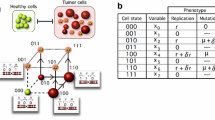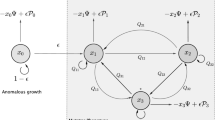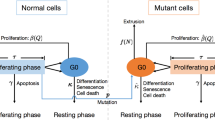Abstract
Cancer is a complex disease and thus is complicated to model. However, simple models that describe the main processes involved in tumoral dynamics, e.g., competition and mutation, can give us clues about cancer behavior, at least qualitatively, also allowing us to make predictions. Here, we analyze a simplified quasispecies mathematical model given by differential equations describing the time behavior of tumor cell populations with different levels of genomic instability. We find the equilibrium points, also characterizing their stability and bifurcations focusing on replication and mutation rates. We identify a transcritical bifurcation at increasing mutation rates of the tumor cells. Such a bifurcation involves a scenario with dominance of healthy cells and impairment of tumor populations. Finally, we characterize the transient times for this scenario, showing that a slight increase beyond the critical mutation rate may be enough to have a fast response towards the desired state (i.e., low tumor populations) by applying directed mutagenic therapies.







Similar content being viewed by others
Notes
The codes used to obtain the results presented in this work are available upon request.
References
Anderson GR, Stoler DL, Brenner BM (2001) Cancer as an evolutionary consequence of a destabilized genome. Bioessays 23:103746
Benedikt B, Siebert R, Traulsen A (2014) Cancer initiation with epistatic interaction between driver and passenger mutations. J Theor Biol 358:52–60
Bielas JH, Loeb KR, Rubin BP, True LD et al (2006) Human cancers express a mutator phenotype. Proc Natl Acad Sci 103:18238–18242
Bjedov I, Tenaillon O, Gérard B, Souza V et al (2003) Stress-induced mutagenesis in bacteria. Science 300(14049):35
Brumer Y, Michor F, Shakhnovich EI (2006) Genetic instability and the quasispecies model. J Theor Biol 241:216–222
Bryan K, Leise T (2006) The \({\$}\)25,000,000,000 eigenvector. The linear algebra behind Google. SIAM Rev 48(3):569–581
Bull JJ, Sanjuán R, Wilke CO (2007) Theory of lethal mutagenesis for viruses. J Virol 81:2930–2939
Cahill DP, Kinzler KW, Vogelstein B, Lengauer C (1999) Genetic instability and darwinian selection in tumors. Trends Genet 15:M57–M61
Cairns J (1975) Mutation selection and the natural history of cancer. Nature 255:197–200
Cichutek K, Merget H, Norlay S, Linde R et al (1992) Development of a quasispecies of human immunodeficiency virus type 1 in vivo. Proc Natl Acad Sci 89:7365–7369
Crotty S, Cameron CE, Andino R (2001) RNA virus error catastrophe: direct molecular test by using ribavirin. Proc Natl Acad Sci 98:6895–6900
Domingo E, Biebricher CK, Eigen M, Holland JJ (2001) Quasispecies and RNA virus evolution: principles and consequences. Landes Bioscience, Georgetown
Eigen M (1971) Selforganization of matter and evolution of biological macromolecules. Naturwissenschaften 58:465–523
Eigen M, Schuster P (1979) The hypercycle: a principle of natural selforganization (Springer-Verlag New York). Naturwissenschaften 58:465–523
Feig DI, Loeb LA (1993) Mechanisms of mutation by oxidative DNA damage: reduced fidelity of mammalian DNA polymerase \(\beta \). Biochemistry 32:4466–4473
Forney GD (1973) The Viterbi algorithm. Proc IEEE 61:268–278
Hastings A (2004) Transients: the key long-term ecological understanding. Trends Ecol Evol 19:39–45
Hoeijmakers JH (2001) Genome maintenance mechanisms for preventing cancer. Nature 411:366–374
Jorba Á, Zou M (2004) A software package for the numerical integration of ODEs by means of high-order Taylor methods. http://www.maia.ub.es/angel/taylor/taylor.pdf
Lauring AS, Andino R (2010) Quasispecies theory and the behavior of RNA viruses. PLoS Pathog 6(7):e1001005
Loeb LA (2001) A mutator phenotype in cancer. Cancer Res 61:3230–3239
Lux T, Morales-Arias L, Sattarhoff C (2011) A Markov-switching multifractal approach to forecasting volatility. Kiel Working Paper, 1737
Marcus PI, Rodriguez LL, Sekellick MJ (1998) Interferon induction as a quasispecies marker of Vesicular stomatitis virus populations. J Virol 72(1):542–549
Merlo LMF, Pepper JW, Reid BJ, Maley CC (2006) Cancer as an evolutionary and ecological process. Nat Rev Cancer 6:924–935
Nowak MA (1992) What is a quasispecies? Trends Ecol Evol 7:118–121
Oliver A, Canton R, Campo P, Baquero F et al (2000) High frequency of hypermutable Pseudomonas aeruginosa in cystic fibrosis lung infection. Science 288:12514
Sardanyés J, Simó C, Martínez R, Solé RV, Elena SF (2014) Variability in mutational fitness effects prevents full lethal transitions in large quasispecies populations. Nat Sci Rep 4:4625
Sergey B, Lawrence P (1998) The anatomy of a large-scale hypertextual web search engine. Comput Netw ISDN Syst 33:107–117
Sniegowski PD, Gerrish PJ, Lenski RE (1997) Evolution of high mutation rates in experimental populations of E. coli. Nature 387:7035
Solé RV (2001) Phase transitions in unstable cancer cells populations. Eur Phys J B 35:117–123
Solé RV, Sardanyés J, Díez J, Mas A (2006) Information catastrophe in RNA viruses through replication thresholds. J Theor Biol 240:353–359
Solé RV, Deisboeck TS (2004) An error catastrophe in cancer? J Theor Biol 228:47–54
Sun W, Jiang T, Lu Y, Reiff M, Mo R, Gu Z (2014) Cocoon-like self-degradable DNA nano clew for anticancer drug delivery. J Am Chem Soc 136:14722–14725
Swetina J, Schuster P (1982) Self-replication with errors. A model for polynucleotide replication. Biophys Chem 16:329–345
Usher MB (1971) Developments in the Leslie model in mathematical models in ecology. Blackwell Scientific Publications
Wylie CS, Shakhnovich EI (2012) Mutation induced extinction in finite populations: lethal mutagenesis and lethal isolation. PLoS Comput Biol 8(8):e1002609
Acknowledgments
We want to thank Ricard V. Solé for helpful comments and suggestions. JTL has been partially supported by the Spanish MICIN/FEDER grant MTM2012-31714, by the Generalitat de Catalunya grant number 2014SGR-504, and by grant 14-41-00044 of RSF at the Lobachevsky University of Nizhny Novgorod. JS has been funded by the Fundación Botín.
Author information
Authors and Affiliations
Corresponding authors
Additional information
Communicated by Maria do Rosario de Pinho.
Rights and permissions
About this article
Cite this article
Castillo, V., Lázaro, J.T. & Sardanyés, J. Dynamics and bifurcations in a simple quasispecies model of tumorigenesis. Comp. Appl. Math. 36, 415–431 (2017). https://doi.org/10.1007/s40314-015-0234-3
Received:
Revised:
Accepted:
Published:
Issue Date:
DOI: https://doi.org/10.1007/s40314-015-0234-3




